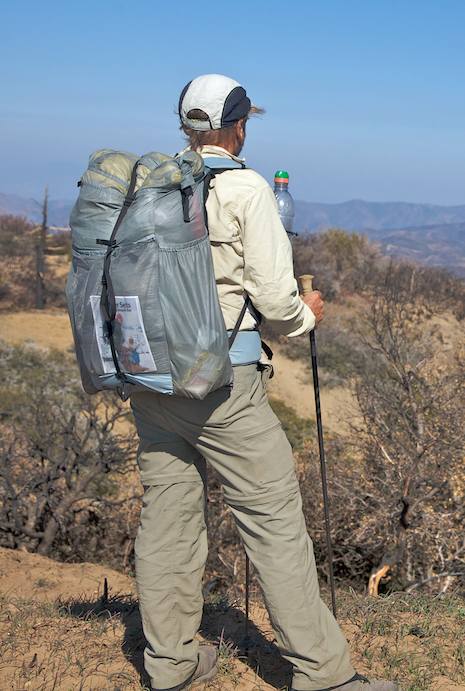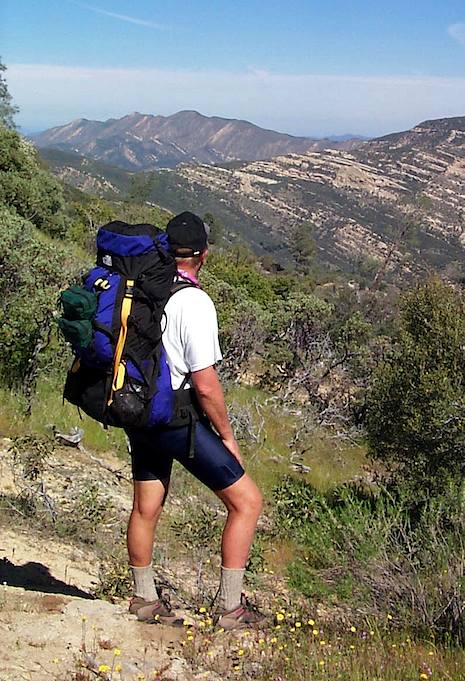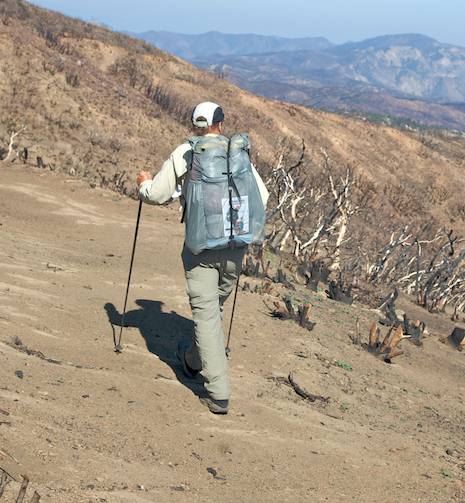The Lure of Going Lite
Shed the Pounds and Have Way More Fun

It no longer takes 40 pounds of gear to get out in the wilderness. With new technology, it’s possible to shave your gear down to less than 10 pounds, not counting food and water. Of course, it requires a bit of re-thinking one’s approach.
When my friend Paul Cronshaw challenged me to compare packs to see whose weighed more – my sturdy North Face internal frame pack I’ve used for years against his Gossamer Gear pack – mine empty to his fully loaded, I took him on with a grin. Turns out mine was the lighter-but barely, and I hadn’t added any gear to it yet!

Not counting food and water, Paul’s pack weighed 8 pounds 6 ounces – with tarp tent for shelter, down bag for sleeping, clothing, safety gear, stove, cup and a few other odds and ends. My pack was completely empty: just a bit over 7 lbs. What’s wrong with this picture, I thought?
Having grown up with Kelty external frame packs, 6-pound boots and tents that weighed more than Paul’s gear, I was used to heading out into the San Rafael Wilderness with at least 30 pounds on my back or more! Paul is a fairly recent convert to going out lightweight and is the case with many newbies, he’s evangelistic about his conversion. “I really needed to make the change,” he tells me. “The weight was killing me. I wasn’t having fun anymore. I knew I needed to do something different or I’d stop going out.” Paul’s new motto is “when the weight goes down, the fun goes up” and he shares it with everyone he meets on the trail.
GETTING UNDER 20 POUNDS
A mutual friend of ours by the name of Rik Christensen mentored Paul in shedding off the pounds. Rik is what is known as a “gram weenie” in backpacking circles. Rik is a retired auto restorer who, like Paul, was ready to quit the sport rather than go out old style anymore. “Once I turned 50 I just couldn’t carry the weight anymore,” he explained. “It was killing me. I was ready to put the pack up on the wall and give it all up.” But as an avid reader of all things outdoors, he became intrigued by the writings of Ray Jardine whose book Beyond Backpacking: Guide to Lightweight Hiking had become the 90s bible for a new style of packing known as “through hiking” – a form of long distance travel that required a minimalist approach.
“My first challenge was to get my pack down to under 20 pounds,” Rik explains as he shows me all of his gear. “Getting there was as much a philosophical issue as it was practical. I was used to sturdy gear, solid stuff, things that were really tough. I really had to re-think how I approached a backpack trip.
“The lighter gear is more fragile, the pack isn’t cordura, it’s a much lighter material known as silnylon which is easy to tear. It also requires using down for insulation rather than synthetics – both because of weight and space savings, but you really have to make sure you don’t get it wet.”
MEMORIES OF A RAINY NIGHT
More fragile gear means not only a higher level of competency but taking a bit more care. This has always been an issue to me since I often head out into the backcountry with others who aren’t as skilled. There is no question that the lighter you go the better you need to be at caring for your gear.
I still have memories of the first trip I took kids from Dos Pueblos on into the San Rafael Wilderness. We spent the night at Fish Camp, which is just upstream from Nira and then worked our way up the Manzana and over the Deck to Happy Hunting Ground. The ground was bone dry and there was barely enough water just below the camp to support us.
That night when the storm came in I thought we were prepared but then it started pouring and within the hour the creek was flowing and the gear was being tested. Mostly this consisted of flimsy tube tents and synthetic sleeping bags. It was a tough night with lots of complaining and by the morning a crew of thoroughly wet and cold campers. No fun. One of the guys was shivering enough he couldn’t get his boots tied so I laced them up for him.
Between the eight of us, we shared dry clothes, helped each other with breakfast, packing up and the task of keeping each other cheered up. We made it out that day and it was tough. Wet clothes, creek crossings that were now a foot deep and lots of slippery mud. Because we could get out we did, but I remember wondering what things might have been like had we been further back in and unable to make it out that day.
My thought for that day was how easy it is to get in over your head. With the advent of lightweight gear there is even more of a premium on knowing your gear, its limitations and your own as well. This isn’t to downplay the importance of going light: but just to point out that along with the tremendous benefits it brings to wilderness camping that it also places a greater responsibility on you to know what you are doing.
BUT WHAT A DIFFERENCE
“But once I’d gotten my gear down below 20 pounds, I couldn’t believe how much happier I was out on the trail,” Rik added. “Then I began to see if I could get my pack weight down to below 10 pounds. The first thing I did was to buy a scale so I could weigh everything. I started counting ounces, seeing where I could save weight and then once I’d saved a few ounces I started seeing where I could shave off a few additional grams.”

Hence the moniker “gram weenie.” Having gone well below the twenty pound barrier, which officially categorized him as a lightweight packer, it didn’t take Rik long to trim enough excess poundage to get him below 10 pounds and into ultra lightweight status. Now Rik rarely carries more than 8 pounds on his back, not counting food and water.
Over the past ten years or so Rik figures he has converted at least four or five dozen to the UL way of packing. “The ones who’ve never been out are the easiest to convince that lightweight packing is the way to go,” Rik explained. They don’t have any preconceptions about anything.”
I can understand this fully when Rik begins to go over his gear with me. The first thing I note is that the pack is way smaller and there aren’t pockets all over the place to store all those odds and ends. Does this mean I’ll have to open up the pack every time I want to find the littlest thing? And that’s just the start. My sleeping pad, for instance, no longer gets rolled up and lashed to the outside of the pack. Because the frame is lighter and has little internal padding, the pad is now folded up and placed inside first so it fits between your back and the gear. Packing things for comfort becomes a bit more complicated too because the suspension system is much lighter and there are fewer cubic inches to fill up any way you want. It’s not that I can’t adjust, but it’s forcing me to do things in a way that’s different. I almost feel like a rookie again, learning how to backpack all over again.
Another issue that every long time packer will need to face as well is that you need new gear to go lite. As I’m looking through all of Rik’s gear I’m not seeing where much of my old gear will work anymore. It’s either too heavy or too bulky to fit into any of the UL packs.
Sooner or later though, I’m starting to realize, I’m either going to make the move or I’ll end up like many others I know my age who’ve given up the sport. Still, I’m wondering, can I really do it?
WHO ME?
“So when are you going to shed the pounds?” Rik dares me. “It’s not too late to go lite.”
Being on the sad side of sixty and with knees that require me to medicate myself with a daily dose of Aleve when I go hiking, I actually don’t require much convincing. I can’t stop going out into the backcountry – it’s in my blood.
Last week Rik and I went on what was my first true UL adventure, a trip down the Sisquoc to check out burn damage from the Zaca Fire. Within the first mile I knew that packing without the weight on my back was definitely the way to go.
Now, if I can only shed those other twenty pounds.



